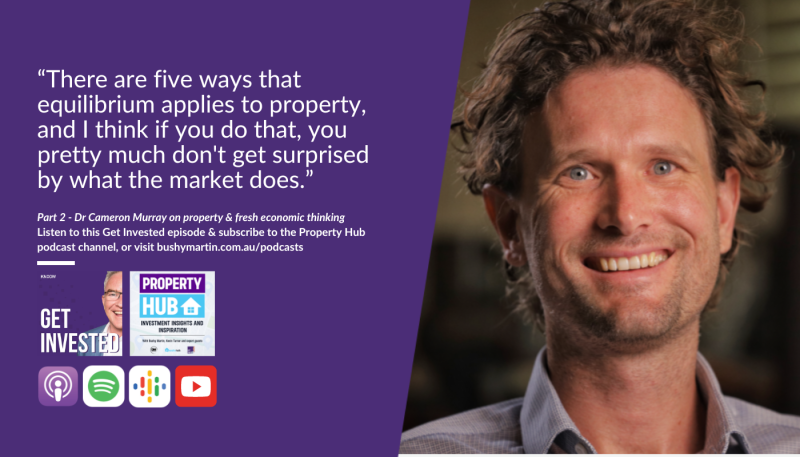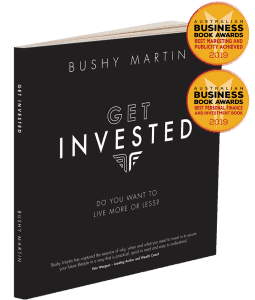Dr Cameron Murray reveals five key economic drivers of property values based on the concept of ‘equilibrium’.
Dr Murray is a highly respected economist and author who specialises in property and housing amongst many other areas.
He joined KnowHow’s Bushy Martin on Property Hub’s Get Invested podcast to explain how understanding the idea of equilibrium will ensure investors and home buyers can be better prepared for changes in the market.
“Essentially what an equilibrium means is when you have a choice between two alternatives, you choose the one that makes you better off. So, for example, if there’s a supermarket checkout where one queue has two people and one has ten, that’s not an equilibrium because the last four people from the ten queue can switch to the other queue, and then it creates an equilibrium because for the next person choosing a checkout, there’s no difference. So I think there are five ways that this applies to property, and I think if you do that, you pretty much don’t get surprised by what the market does. It’s very comprehensive,” Dr Murray explained.
Asset price equilibrium
Dr Murray talked about how property is an asset which is affected by conditions in all asset markets – an insight which will allow investors to take a ‘huge step’ to understanding the evolution of house prices over time.
“For every dollar you spend on property, you could spend it on some other asset, right? So you put a dollar in a share market, you can put it in the bank, you can put it in property. So they’re like the two supermarket queues – property, or other assets. And so over the long run, the rate of return on each asset should be the same. And if it wasn’t, people would have swapped their money, they would have sold property and bought shares or vice versa. And if you look at long term studies of the rate of return on different assets, it’s around 7% for the last hundred years in any asset class. And it must be, because if it was systematically different, people would swap from one to the other. And so the asset price equilibrium is that the asset price of houses is affected by what’s happening in all the asset markets in the economy,” he said.
“That’s why, for example, we use monetary policy to influence asset prices, because if the return on cash goes down, people don’t want to hold cash, they want to hold other assets, so they switch from cash to property. So that’s, I think, the key insight. Part of that too is that undeveloped property, where you can build houses or can build offices, is also an asset, right? It’s got a value and it makes a return from capital gains. And you can switch that into cash, or you can switch it into a building by combining it with other assets with cash to do construction.
“Now, it doesn’t mean it’s always equal. Asset markets are renowned for being cyclical, and guess what? So is the property market, because people are second guessing each other and we end up going one way or going the other.”
Rental equilibrium
The second concept explores the relationship between household incomes and rent prices.
“Housing, for example, gets its value from rent. That’s the income flow that you get. So where do rents come from? Well people have the choice of spending on housing, or spending on other goods and services, right? And so if you’re spending 10% of your income on housing, you might go, oh I could spend an extra 10% and rent a better house or at a better location. And so I’m going to keep spending more of my income on housing until there’s no benefit from trying to get a better house or buy other consumer goods and services. And the interesting part about that is that, for the past 100 years, households have roughly spent 20% of their income on housing. And of course the reason rents are going up in a lot of places is because incomes are going up. They don’t go up by themselves, they go up because people are paying because you’re only outbidding the next renter, and they’re using their income to outbid you. So a lot of people spending a lot of their income on housing,” Dr Murray said.
“One of the issues we’re seeing now is, because incomes are changing at different rates for different types of people, different households are adjusting and moving and outbidding other households whose incomes didn’t go up. And so you’re getting this shuffling of the deck at the moment, but you’re getting the rental equilibrium 20%. So therefore, if incomes go up, rents go up and prices go up, because prices are capitalised rents based on conditions in asset markets.”
Spatial equilibrium
The third equilibrium addresses the choice of location.
“So you can either choose to live in one location or another, and if the benefit exceeds the extra cost of moving, of course you move. And so that’s why young people move to the big cities. That’s why, internationally, people move into Sydney, and that’s why many locals move out of Sydney when they get outbid by other people because they can get similar incomes in other areas and they can get a lot cheaper housing. So the net benefit of moving is there,” Dr Murray said.
“So there’s a gradient then in terms of rents within cities, within suburbs of cities, between cities, and that’s why there’s that gradient. It’s an equilibrium outcome of a few people adjusting to sustain those different rents. And that’s why, for example, you get increasing rents when you get lots of development in an area, because it becomes a relatively more attractive place to live when there are shops nearby and a pool and a school and all that sort of stuff. So the benefit of moving there outweighs the cost.”
Density equilibrium
The density equilibrium refers to how ‘on any property at a particular location, there is a density of housing at a point in time that will make you the most money’.
“So out in the suburbs it might be detached houses on lots that are 400 square metres, but a few suburbs over it might be detached houses on 300 square metres, and in another suburb it might be townhouses, and in another suburb it might be low rise apartments. So it doesn’t quite justify the cost of a high rise. But then in the centre, it’s just high rises everywhere. And so what that shows is that even if you try and create planning regulations to get more density in regional areas or in outer suburbs, it might not happen because it makes you less money to build a high rise then to build some townhouses because the price per square metre that you sell for can’t justify the cost of building a high rise. So you can’t just plan for high density. There is a market limit as well,” Dr Cameron said.
Absorption equilibrium
Finally, absorption equilibrium is the rate at which property owners take up opportunities to build houses.
“So essentially the two supermarket queues are choosing to build today, or build tomorrow. Because you don’t have to build properties. There’s not an obligation to build. So you choose when to do it and how quickly. And if you’re building too fast today, you’d actually make more money taking that last dwelling out of the queue today and putting it into tomorrow’s queue. And so what that means is that when prices are rising quickly in the cycle, everyone wants to build at those periods, because that’s the time when putting stuff in the future is not worth it, whereas when prices are soft or not rising, then you’ve got this benefit from delay. And that’s the absorption equilibrium,” Dr Murray explained.
“If you can understand that, you can sort of see why the idea of making all the houses cheaper by just letting people build doesn’t work because they don’t want to build faster. There’s a built in speed limit here because if they build faster, they’d make less money tomorrow. So across all these property owners in the market, there is an optimal rate to convert undeveloped property assets into developed ones.”
Listen to the full interview here.
Want to Know How you can build wealth and optimise your property finance with the help of leading, qualified experts? Check us out and talk to the team, now.




